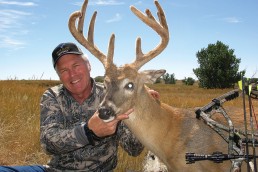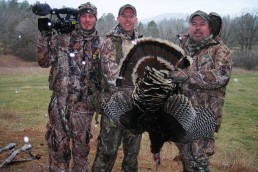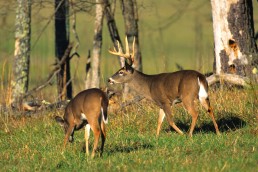Top Early-season Bowhunting Destinations for Velvet Racks
SHARE THIS POST
By Bernie Barringer
Ever have the hankering for whitetails that still have velvet-covered antlers?
Whitetails across North America tend to shed their velvet during the first week in September. Sometimes the fuzz can come off during the last week of August, but the majority will become hard-antlered deer the first week of September. There are a handful of locations across the continent where you can legally hunt one early and have a great chance of shooting a velvet buck at this time.
These opportunities offer several positive aspects to the hunts. Not only does the season open early when the majority of the bucks have not yet shed their soft antler covering, but these bucks are in some of their most consistent, predictable patterns of the year.
Here are my top picks for getting a velvet buck for your trophy collection.
Public land in North Dakota
North Dakota is a gold mine for the DIY bowhunter. Public land is abundant, and there are some places where hunting permission will be granted, on a handshake. Tens of thousands of acres of U.S. Army Corps of Engineers (ACOE) land surrounds the Missouri River and its reservoirs. All of them are open to the public for hunting the velvet deer. Much of it is grassland, but food plots, shelterbelts and oak groves left over from century-old farmsteads can attract whitetails.

Lake Sakakawea is a huge reservoir that’s 125 miles long. Almost the entire shoreline here is ACOE land. You could spend a lifetime poking around looking for these whitetails. Much of this area has a very low human population and little hunting pressure during archery season.
North Dakota also offers a program known as PLOTS (Private Land Open to Sportsmen). Landowners allow public access to their land through this program. The good news about PLOTS land is that no access by any type of vehicle is allowed, as it’s “walking only.” The vast majority of this land is prairie that attracts bird hunters, but one who does his or her homework can find the small pockets of great whitetail habitat that rarely get hunted. Because it’s walking-access only, anything a mile or so from the nearest road may never see a deer hunter.
Most locals here have a place to hunt where they don’t have to hoof it so far. Surprisingly, few nonresident hunters take advantage of North Dakota’s whitetail opportunities. You will have to do your homework and be willing to work hard to bag a buck in North Dakota. But if you like the challenge a DIY-type of road trip offers, this could be the hunting location for you.
Southeastern Montana
While northeastern Montana gets a lot of publicity for whitetail hunting, the southeastern corner of the state has quietly been producing some really nice bucks. Because the season opens September 1, there is a short window of opportunity to bag a velvet buck. This area has escaped the plague of Blue Tongue disease and the winterkill that has caused a crash of the deer population in northeastern Montana.
Look to the lowlands along the watersheds of the Powder and Tongue rivers for numbers of whitetails and quality of deer that will surprise even the most seasoned bowhunting road-tripper. This is ideal arid country with its river bottoms surrounded by sagebrush-covered hills. The deer bed in the cottonwood groves during the day and move out into the irrigated alfalfa fields to feed. Their patterns are consistent, and the sheer numbers of deer are striking. It’s not unusual to see 50-plus deer per sitting. The first week in September last year, I saw nine Pope & Young bucks in velvet during a four-hour evening sit in 90 degrees. The majority of the properties here with good deer populations are leased by outfitters. Most of these outfitters offer hunts for whitetails, mule deer plus antelope, especially if you want to combine these into one hunt. This is one of those hunts that every serious bowhunter should put on their must-do list. I once bagged a great 10-pointer in 2012 with Blue Rock Outfitters and can’t wait to get back there.

Alberta (forest fringe area)
Alberta has been known to produce trophy whitetails due to its low hunting pressure as the cold northern climate dissuades the hardiest hunters during the frigid rifle season. But for bowhunters, Alberta is not at the top of their destination list. It should be on yours, though. The opportunity is there to take a whopper in velvet during the first week of September. In fact, there are some larger areas designated as “primitive weapons only.”
The nonresident hunters must be “hosted” by an Alberta resident. Unless you have a friend or family member in this province that has access to good hunting land, you must go with an outfitter to legally hunt. One other option is to “trade a trip” where you might find an Alberta resident who would be willing to host you in exchange for a hunt in your own home area.
Southern Alberta is prairie land, the North is boreal forest, and the western part of the province is mountainous. Nestled between those areas is the forest fringe, commonly called the “Parkland” by residents. This combination of farms, open prairie and patches of “bush” is where you’ll find the best early-season hunting. The velvet deer tend to bed in the heavy cover of the timber blocks and feed in the open fields. They are quite visible and have predictable patterns in this flat country. Whitetail numbers are not high here, but the quality makes up for the lack of quantity.
Occasionally, the bucks will bed for the day in open fields and can be taken by spotting them in the morning or watching them bed, and then putting the sneak on them when they have settled in. This is not a high-percentage tactic, but it is exhilarating and sure beats sitting around a camp all day. Bagging a mature whitetail this way is one of the most rewarding feelings in deer hunting.
Northeastern Wyoming
Much like southeastern Montana, this area in Wyoming by no way resembles typical whitetail country to the Midwestern or Eastern hunter. But the water and fertility of the land associated with the riparian areas produces whitetails in significant numbers, and the scarcity of local deer hunters allows them to get mature. This part of the West is not much of a secret any longer as outfitters have grabbed up the majority of the best ground. There are a few places where you can get permission to hunt, but most of the landowners have figured out that people will pay to hunt the whitetails that they consider “vermin.” If you’re willing to put in the time and knock on a lot of doors and be courteous, you can find a place to hunt on your own.
Cottonwoods and alfalfa are the two main keys to whitetail location early, although the bedding areas may be in a pine grove a mile or more from the feeding areas. It’s common for deer to cross the vast areas while they make their way to the fields to feed in the afternoon; they commonly walk two miles or more. This makes them very visible, but a spotting scope is an essential tool. Once they’re found, it’s a matter of getting into position for their morning or evening trek that takes place (mostly) during the first two and the last two hours of daylight.
Are you enjoying this post?
You can be among the first to get the latest info on where to go, what to use and how to use it!
Western Kentucky
The western half of Kentucky has earned a well-deserved reputation for being a quality whitetail destination. In the last two decades, the numbers of mature deer being shot by residents and nonresidents has risen. Offering an archery season opener that falls on the first Saturday in September, this Midwestern gem offers yet another opportunity to bag a great velvet buck.
For hunters without the budget to spend on a fully outfitted hunt, this area offers an abundance of public land open to hunting. Western Kentucky features two expansive public areas in the 100,000-acre Land Between the Lakes Wildlife Management Area and the 65,000-acre Peabody Wildlife Management Area. In addition, there are several smaller WMAs ranging in size from less than 1,000 acres to more than 8,000 acres. This area is well populated and you will not be alone on this public hunting ground. But if you’re willing to do your legwork—including get a mile or more off the road—you can find minimal hunting pressure.
Landowners are generally open to allowing bowhunters access to their properties, but not so much for rifle hunters. While there are a handful of outfitters operating across the western part of the state, there is no shortage of private land that’s not bound up by hunting leases.
The unique trophy of a velvet-antlered whitetail is one that can be found in only a handful of places. If you start planning now you have a chance to get yours early.
MWO
Early-season Deer Bowhunting Seasons
Kentucky
Season opener: First Saturday in September
Licenses and tags: OTC, $190
fw.ky.gov
North Dakota
Season opener: Noon on the Friday nearest September 1.
Licenses and tags: OTC – $215
gf.nd.gov
Alberta
Season opener: September 1
Licenses and tags: Hosted – $196.57
mywildalberta.com
Wyoming
Season opener: September 1
Licenses and tags: Apply between January 1 and March 15 – $338.50
wgfd.wyo.gov/web2011/home.aspx
Montana
Season opener: September 1
Licenses and tags: Apply between January 1 and March 15 – $552
fwp.mt.gov
Bernie Barringer has hunted big game with a bow in more than a dozen states and in multiple Canadian provinces. Passion drives him to learn more and hunt new places, and this column is your ticket to his travels. The author of 13 books and thousands of articles, you can find even more from him at bowhuntingroad.com and BowhuntingRoad on YouTube.
MWO
SHARE THIS POST
Did you enjoy this post?
You can be among the first to get the latest info on where to go, what to use and how to use it!
Dave Mull
Dave Mull of Paw Paw, Mich. has spent his career communicating the outdoors experience and runs Inner Viking Media. He enjoys kayak fishing for anything that swims in the lakes and rivers of the Midwest and beyond, and even uses his MirroCraft, from time to time. Available for seminars.



